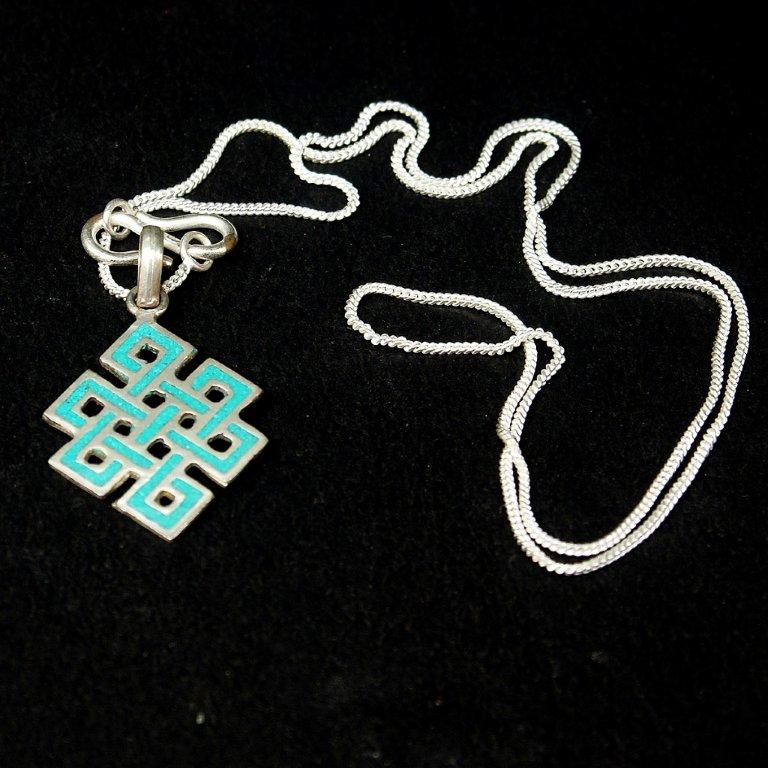About Turquoise :
Turquoise is perhaps the oldest stone in man's history, the talisman of kings, shamans, and warriors. It is a stone of protection, strong and opaque, yet soothing to the touch, healing to the eye, as if carved from an azure heaven and slipped to earth. Its unique shade of blue, often blue-green, lends it name, Turquoise, to all things of this tranquil hue. The delicate veining or mottled webbing in cream or brown is inherent to the stone and serves to enhance its character.
Metal Pendant
A Nepali metal pendant is a traditional piece of jewelry that is crafted in Nepal using traditional techniques and materials. The pendant is typically made of metal, such as brass or silver, and is intricately designed and embellished with cultural motifs and symbols.
The design of the pendant may be inspired by Nepali culture and symbolism, with patterns and motifs that represent different aspects of Nepali life, such as nature, religion, or social customs. These designs may be created using traditional techniques, such as etching, stamping, or engraving, and may be further embellished with beads, gems, or other decorative elements.
Read More
The pendant may be worn on a chain or cord around the neck, and is often used as a statement piece or as a talisman to protect the wearer from negative energies or evil spirits. It is also commonly given as a gift to family members or friends, particularly on special occasions, such as weddings or religious ceremonies.
Overall, a Nepali metal pendant is a beautiful and unique piece of jewelry that represents the rich cultural heritage of Nepal and the skill and artistry of its craftsmen. It is a treasured possession that carries deep meaning and significance for those who wear it or receive it as a gift.
Turquoise : Brief Introduction
Turquoise is a purification stone. It dispels negative energy and can be worn to protect against outside influences or pollutants in the atmosphere. Turquoise balances and aligns all the chakras, stabilising mood swings and instilling inner calm. It is excellent for depression and exhaustion, it also has the power to prevent panic attacks. Turquoise promotes self-realisation and assists creative problem solving. It is a symbol of friendship, and stimulates romantic love.
Turquoise aids in the absorption of nutrients, enhances the immune system, stimulates the regeneration of tissue, and heals the whole body. It contains anti-inflammatory and detoxifying effects, and alleviates cramps and pain. Turquoise purifies lungs, soothes and clears sore throats, and heals the eyes, including cataracts. It neutralises over acidity, benefits rheumatism, gout, stomach problems, and viral infections
♥ Purification ♥ Serenity ♥ Protection ♥ Wisdom ♥ Balance ♥ Strength ♥ Friendship ♥ Love ♥ Positive thinking ♥ Sensitivity
Turquoise is a mineral that is a hydrous phosphate of copper and aluminium. Turquoise is an 11th Anniversary gemstone.
Chakras - Heart Chakra, Throat Chakra, Third Eye Chakra
Birthstone - December (Blue Turquoise)
Zodiac - Scorpio, Sagittarius, Aquarius, Pisces
Planet – Venus & Neptune
Element – Earth/Air/Fire
Vibration - Number 1
Typical colours - Turquoise, blue, green, yellow-green
Read More
Endless knot : About Endless Knot, Srivatsa
The endless knot or eternal knot (Sanskrit: śrīvatsa; Tibetan དཔལ་བེའུ། dpal be'u; Mongolian Улзии) is a symbolic knot and one of the Eight Auspicious Symbols. It is in important symbol in both Jainism and Buddhism. It is an important cultural marker in places significantly influenced by Tibetan Buddhism such as Tibet, Mongolia, Tuva, Kalmykia, and Buryatia. It is also sometimes found in Chinese art and used in Chinese knots.
In Jainism it is one of the eight auspicious items, an asthamangala, however found only in the Svetambara sect. It is often found marking the chests of the 24 Saints, the tirthankaras. It is more commonly referred to as the Shrivatsa.
